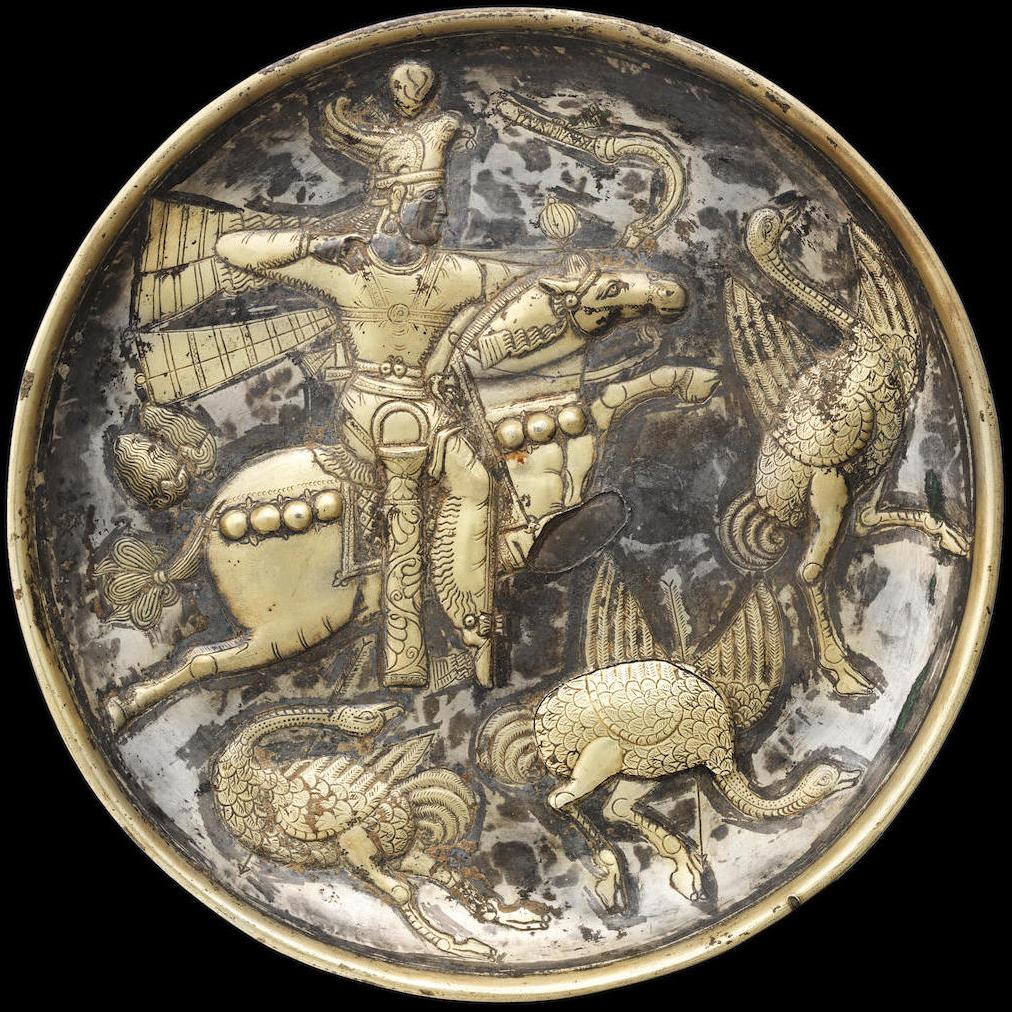|
|
Sasanian silver-gilt plate of Hormizd II Hunting Ostrich. Early 4th Century A.D.

A Sasanian silver-gilt royal hunting scene plate
Iran, circa early 4th Century A.D.
The interior decorated in relief, the figural scene with gilding and finely incised details, depicting a king, thought to be Hormizd II,
riding a horse at flying gallop to right, the king wearing a crown in the form of a winged eagle surmounted with a globe,
with three rippling streamers flying out behind, wearing a chest halter over a belted tunic, and trousers with pleated edging, wearing a quiver at his right hip,
decorated with a wavy palmette tendril and a rosette above, a beribboned sword hilt on his left, seated astride the horse with a dotted cross-hatched saddle blanket,
a pair of incised balloons fly out behind, a rippling ribbon attached to its bridle with a ribbed globe above, wearing a harness ornamented with large bosses,
its tail elaborately tied, the king drawing a bow, taking aim at a fleeing ostrich or great bustard in front, two shot birds below,
one collapsed with an arrow through its turned neck, the other shot through its breast, the plate on a ring foot,
the base with a dotted Pahlavi inscription mentioning the weight, and two monograms (23.3cm) diameter; 791.9g weight
Footnotes
Provenance:
Private collection, Switzerland, acquired between 2002-2005.
European private collection, UK and Switzerland, formed in the 1970s and 1980s.
Literature:
Royal hunting scenes were an important motif in Sasanian art, depicting kings and the royal family as gloriously-attired, and full of vigour and skill.
For further discussion, cf. P.O. Harper, The Royal Hunter: Art of the Sasanian Empire, New York, 1978.
Many of these gilded silver plates show similar scenes of kings hunting boar, rams, stags and lions. The representation of an ostrich or bustard however is extremely rare.
There is a silver plate in Japan depicting another scene of ostrich hunting: K. Tanabe, 'Unique Sasanian Silver Plate with Bahram Gur's Ostrich-Hunting Scene and with Gold Inlay'
Bulletin of the Ancient Orient Museum, 2, Tokyo, 1980, pp. 45-68.
The eagle crown is an important feature of this plate and according to Judith Lerner, 'only two kings include an animal protome' on their crowns:
Shapur I (A.D. 241-272) and Hormizd II (A.D. 302-309).
See J.A. Lerner, 'Animal Headdresses on the Sealings of the Bactrian Documents', in Iranica 17. Exegisti Monumenta: Festschrift in Honour of Nicholas Sims-Williams, Weisbaden, 2009, p.220.
The bird-headed crown with wings is most frequently associated with Hormizd II and this plate shows the king wearing a specific crown of a winged eagle with two pearls in its mouth.
Hormizd II wears such a crown on many of his coins and is also shown wearing a similar crown on the equestrian relief at Naqsh-e Rustam: E.F. Schmidt, Persepolis volume III.
The Royal Tombs and Other Monuments, University of Chicago Oriental Institute Publications, LXX, Chicago, 1970, pl. 91-2.
There is also a silver gilt plate in the Cleveland Museum of Art (acc. No. 62.150) depicting Hormizd II (but produced about 150 years after his reign) wearing the same crown: cf.
P.O. Harper & P. Meyers, Silver Vessels of the Sasanian Period: Volume One. Royal Imagery, New York, 1981, pl. 14, pp. 61, 127-8.
It is possible that the plate is meant to depict Hormizd II as a young prince,
as he is shown without his usual beard and with straight hair reminiscent of his father Narseh's style.
Sasanian crown princes are often shown without beards, for example a coin for Bahram II (A.D. 276-293) shows the king with his wife and son, and the crown prince is clean-shaven.
Cf. A. U. Pope, A Survey of Persian Art, volume IV, London and New York, 1938, p. 251, fig. J.
The inscription on the reverse of the plate is composed of a linear inscription in Pahlavi and two figure-like elements or monograms (one rendered as a person with Antelope's horn)
which appear to be a combination of letters.
The larger monogram may perhaps be read as: Ch,M,Sh,T [Ch(a)MSh(i)T], which can be transliterated as 'Jamshid'.
The smaller monogram is the one seen on the crown of Kermanshahs and appears to be the same formula as GDH which is a Pahlavi monetary legend translated by Rika Gyselen as xwarrah
'royal glory appears' but it has also been translated as 'ever increasing greatness'.
The linear inscription may be translated as giving the weight of the bowl, according with the weight given above.
However it has also been suggested that the inscription can be read as
Sh (i) R R U Y ----- T K(?) A B L(R) ---- Z(?) ----- A H(?) L(R) M Z K(?) Y(?) which may be transliterated as
'Shir rooy - Takavar - Ahurmazd kay' and translated as 'Lion face and warrior King Hormizd'.
Bonhams 2014 Lot 107
|
|
